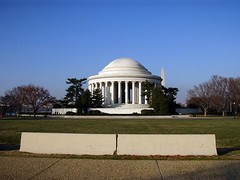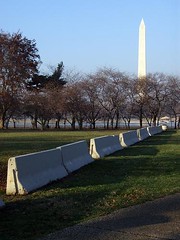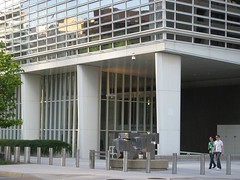City living in an age of hyper-security: it's not what it used to be

Posted July 24, 2009 at 1:35PM
Several times each day, a military helicopter flies over my house. It flies much closer to the ground than other aircraft, and it's seriously noisy. We don't know why, exactly, since in DC you tend just to accept these things, but it started after September 11. We live in a neighborhood with a lot of embassies, and the Department of Homeland Security's campus is only about a mile away, so those seem the likely factors.
When I walk through some of the embassies on my way to the metro, there are ugly "jersey barriers" (those concrete things in the photos) several feet out into the street to keep cars from getting too close. 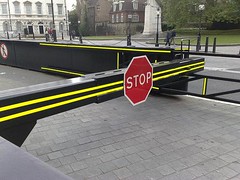 When I get to the office, I have to pass through security gates to get up to NRDC's suite. Our beautiful (and recently LEED-gold-certified) building has two entrances from the street, in theory, but one of them is locked to visitors. Ironically, you can no longer access 1200 New York Avenue from New York Avenue. Go figure.
When I get to the office, I have to pass through security gates to get up to NRDC's suite. Our beautiful (and recently LEED-gold-certified) building has two entrances from the street, in theory, but one of them is locked to visitors. Ironically, you can no longer access 1200 New York Avenue from New York Avenue. Go figure.
I used to go to meetings in Congressional offices or the Capitol with minimal obstruction. One of the great pleasures of a meeting at the Capitol was to exit from the west front and walk down the grand steps where the inaugurations are held, with a splendid view of the National Mall, Washington Monument and, in the distance, the Lincoln Memorial. The west front and access to the grand steps are now closed. If I go to visit EPA's smart growth office, as I do with some regularity, I have to walk all the way around their huge building to get to an entrance that visitors can use, identify myself, go through a metal detector, and wait for an escort to come down to the entrance and take me up to the office.
This kind of thing doesn't happen only in Washington, of course. It's pretty much everywhere now, though perhaps especially so here because of the many institutions that are here. In short, one of the ways in which city life isn't what it used to be is that so much of what used to be public is no longer public. As a result, some of our humanity is lost, to say nothing of efficient travel.
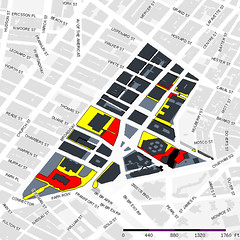 And now there's a website dedicated to the subject. Visit Secure Cities: Security Zones and Shrinking Public Space and you will learn that fully 17 percent of the theoretical "public space" - streets, sidewalks, plazas, and the like - in New York, Los Angeles, and San Francisco "is closed entirely or severely limits public access." For example, on the map of New York's Civic Center district, everything in red is closed off entirely; everything in yellow is limited access only. Go to their site, navigate to the map (or another map in one of their study locations), click on one of those areas, and you can see actual photos of the barriers.
And now there's a website dedicated to the subject. Visit Secure Cities: Security Zones and Shrinking Public Space and you will learn that fully 17 percent of the theoretical "public space" - streets, sidewalks, plazas, and the like - in New York, Los Angeles, and San Francisco "is closed entirely or severely limits public access." For example, on the map of New York's Civic Center district, everything in red is closed off entirely; everything in yellow is limited access only. Go to their site, navigate to the map (or another map in one of their study locations), click on one of those areas, and you can see actual photos of the barriers.
Here's the stated rationale for the site and the research:
"Even before these terror attacks, owners and managers of high-profile public and private buildings had begun to militarize space by outfitting surrounding streets and sidewalks with rotating surveillance cameras, metal fences and concrete bollards. In emergency situations, such features may be reasonable impositions, but as threat levels fall these larger security zones fail to incorporate a diversity of uses and users."
It's true, and we get all too used to it all too easily. Writing on MetropolisMag.com, Julia Galef notes that "the jury is still out on how these security zones affect the way people feel, act, and interact with each other," or even the degree to which people are aware of them. These are all logical next steps for the research.
John Hockenberry, writing on MetropolisMag.com in 2006, was less charitable:
"Concern for security in a suddenly uncertain age has certainly reshaped psychology, politics, and design in America, but it has undoubtedly had the most direct impact on architecture. For any public space, security has become a complex, layered concept that covers detailed blast specifications of window glass as well as issues of controlled access, electronic passkey systems, street-level vehicle barriers, and exterior surveillance. Open spaces have become either suspect urban no-man's lands or bleak accommodations to street setback requirements, bristling with barriers and cameras that anticipate visiting trucks packed with C4 explosives, not bubbly tourists packed with cameras and guidebooks. In an era of suicide bombers, places without checkpoints seem almost naked, like windowless buildings or unfenced playgrounds."
Hockenberry's article is highly informative and thoughtful, and I recommend it to those interested in the subject.
The Secure Cities site also contains references and an explanation of their methodology. It is all new, but they also have the beginnings of a blog where they will provide related news. The project is headed by Jeremy Nemeth, director of the urban design program, at the University of Colorado - Denver.
